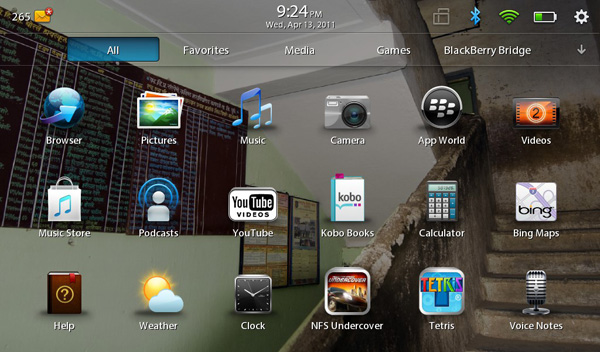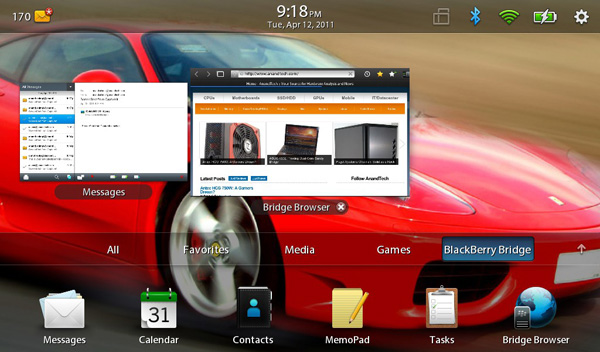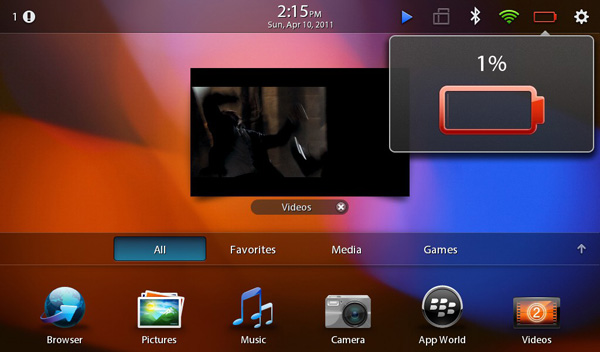The BlackBerry PlayBook Review
by Anand Lal Shimpi on April 13, 2011 9:00 PM EST- Posted in
- Tablets
- Smartphones
- RIM
- BlackBerry
- PlayBook
- Mobile
A New Home
Like many things, when talking about home screens there's a spectrum of options. On the simplest end we've got Apple with iOS, and for the ultimate in complexity there's a full blown desktop OS like Windows or OS X. In between there's Android and somewhere between iOS and Android we have the PlayBook OS.
The default home screen is your typical grid of apps. You can collapse the grid down to a single row of six icons in landscape mode, or view the full grid. RIM provides five tabs to help sort through apps: All, Favorites, Media, Games and BlackBerry Bridge (the latter only appears if you have Bridge enabled).
There's no support for folders, although you can rearrange icons and uninstall apps directly from the home screen the same way you would under iOS.
App launches are unfortunately a bit high latency. Select an app and you'll first see it launch as a thumbnail, then zoom in and finally run full screen. The whole process takes a couple of seconds but it feels longer than firing up similar iOS or Honeycomb apps.
Above the app grid is the multitasking UI, although you need to have at least one active app to see it in action:
Multitasking is smooth and well executed on the PlayBook. To switch between active apps just swipe left to right (starting from the left or right bezel, inner-screen swipes are application specific). You can also swipe up from the bottom bezel (the unlock gesture) while you're in an app to bring up a horizontal list of thumbnails of currently running apps. When in this thumbnail view you can swipe left to right to scroll through the list of apps, flick up (or hit the x) to quit apps and tap on a thumbnail to select and switch to an app. It's all clearly very webOS inspired, although I will say that webOS still feels a bit better in this regard.
Apps continue to run while you're deciding what to switch to. For example, if you're playing a video the player thumbnail will continue to animate while you select your next app. Only once you've selected that app will the video player pause.
RIM also gives you the option to control how background apps behave. By default background apps are paused once you switch away from them, however you can set them to keep running all the time or pause immediately upon activating the task switcher.
Scrolling through running apps is (for the most part) very smooth, with the UI running at 60 fps. The multitasking UI is extremely well done and honestly one of the most impressive parts of the PlayBook experience.
Notifications
With no email or calendar apps, the PlayBook doesn't have a whole lot to notify you of. Presently the only notifications the PlayBook will deliver have to do with remaining battery capacity.
Notifications on the PlayBook work by coloring a corner of the screen (I've seen this happen in both the upper left and upper right corners) if you're in a full screen app. Use the peek gesture to reveal the status bar and you'll see a little icon representing the app that spawned the notification. As I just mentioned, the only notifications that exist today are from the OS telling you that your battery is low but ultimately you'll see notifications from other first and third party apps here.
PlayBook's notification system is clearly a work in progress. Currently if you're charging a fully discharged PlayBook you'll get a notification every 1% between 0 and 6% telling you that the battery is low as you charge it. Also the only notification color supported today is red, which works well for "hey you're running out of battery life!" but not so well for "hey you just got 3 emails".
The notification system on the PlayBook has the potential to be decent. I expect that RIM will tweak the notification system over the coming months to accommodate other applications and services using it. The foundation is solid and RIM seems to be listening to feedback so I have hope for this working well.
There's also a notification LED on the front of the PlayBook, to the left of the front-facing camera. Today all it does is glow red when you turn on the PlayBook, but you can eventually expect it to have more BlackBerry-like functionality as RIM rolls out other things that can notify you (think emails).














77 Comments
View All Comments
Andrew911tt - Thursday, April 14, 2011 - link
You have the Xoom at a price of $799 but you can get the 32 GB wifi version for $599http://www.amazon.com/MOTOROLA-XOOM-Android-Tablet...
MTN Ranger - Thursday, April 14, 2011 - link
Excuse my off topic question.Anand, I notice you use Lafayette Village in your videos a lot. Do you live/work near there? We enjoy having drinks at the Village Grill and my wife loves the Upper Crust Bakery. I have taken photos there and think the architecture is great.
Anand Lal Shimpi - Thursday, April 14, 2011 - link
I'm not too far from there. It's the most interesting thing that I can photograph quickly outside of my dogs playing :)Take care,
Anand
jensend - Thursday, April 14, 2011 - link
I'm serious- this is probably the best commercial OS out there. Of course, these days most people judge an OS mostly by its included applications and the collection of software written for it, which doesn't look so good for QNX, but as far as the actual OS is concerned QNX is extremely well designed.baba264 - Friday, April 15, 2011 - link
I would tend to agree.I was very impressed upon reading all the nice features that this OS has and that are still lacking in mainstream PC OS.
The the tight kernel, the sandboxing, the thread management, the corruption protection all of it sounded real nice. Of course since it wasn't the focus of the article, many question remain, especially performance wise, still it sounded like an impressive work.
vision33r - Friday, April 15, 2011 - link
Because people are used to the iPhone / iPad and App Store being the standard.QNX is a good OS, it is tight and lean. There won't be a fragmentation problem like Android has.
The only problem is that RIM will restrict the device's functionality so that it cannot replace a Blackberry device and risk losing lucrative smartphone sales.
B3an - Friday, April 15, 2011 - link
"You can't really hover to expose controls with a touchscreen so what you end up doing is a lot of quick tapping to try and bring up controls, change the setting you want and get back to playing the video. It's frustrating and doesn't work all of the time. None of this is RIM's fault, but now that tablets are at the point where they can start to behave like notebook/desktops web developers will have to rethink the way they build websites. "I'm a web designer and specialise in interactive websites and apps, but touch screens have the ability to hold this area back and make it less elegant/messy for other devices with no touch.
The problem is not with web sites designed for non-touch devices but the need for a touch device to support hover in some way. For instance this could be done if a touch screen could detect a finger hovering over an area of the screen within say half an inch of the screen surface. That could work well if done right.
As sites get more interactive and advanced hover controls in the UI make more and more sense. because of interface complexity rises and the need for more buttons and stuff all over the place.
The thing with Flash is that being as it's far more capable than HTML5 for interaction (and with pretty much anything else too) is that it's Flash that is more likely to use hover controls in some form. But some HTML5 things are stating to use it, like the default skinned Chrome HTML5 video player for instance. Hover just makes perfect sense for certain things and touch screens need to fix this, not us web designers.
ElementFire - Friday, April 15, 2011 - link
This is a seriously well-wrought review. I'm especially glad you dedicated an entire section to Bridge, and addressed the free tethering question. As you stated, this is huge (assuming the carriers permit it), as it's the closest thing to truly unlimited browsing data plans (for no additional charge!) as we'll get now.It's a pity that Android apps need to be re-signed by RIM before they'll run. It makes sense from a security perspective (you don't want malicious apps running amok on an enterprise platform), but I'd have preferred if RIM had severely limited Android VM capability and allowed all apps to *try* to run, rather than requiring re-signing; the vast majority of Android app-developers won't have the impetus to resubmit their apps to yet another platform holder.
The last point I wanted to make was video conferencing: it's a serious letdown to only ship with point-to-point video chat (and even then, only between PlayBook owners!). If you're aiming at the enterprise, I'd expect VoIP/SIP capability and the ability to run WebEx natively. Does the PlayBook support any implementation of Java Runtime Environment?
name99 - Saturday, April 16, 2011 - link
"Pretty much no smartphone or tablet we've tested is particularly speedy over WiFi. Even the Motorola Xoom, at the top of our performance chart, manages a meager 36Mbps. Part of this has to do with the fact that all of these devices are power rather than performance optimized and part of it has to do with NAND performance limitations."Is this not simply a reflection that none of these devices use 40MHz wide channels, they all stick to 20MHz wide channels? I'm not certain about this, but given how the numbers cluster, I would bet this is the case.
(And, of course, none of these devices use multiple antennas for wifi.)
The flash has nothing to do with it. iPad flash can write sustained at a little under 20MB/s (ie 160 Mbs/s) and I imagine other tablets have similar specs.
In theory, the most power efficient way to run wifi is to do get your transmissions done as fast as possible --- in other words use 40MHz and multiple antennas and run at the maximum data rate possible. Of course this requires that the chips being used be maximally efficient in their overhead, so that essentially all power is being burned in RF transmit, not in the receivers, the decode logic and so on. It may well be that the chips supporting 40MHz, let alone MIMO, simply haven't been around for long enough to have their power usage tuned to where the 20MHz chips are.
tipoo - Sunday, April 17, 2011 - link
Most routers and laptops will default to 20MHz anyways.